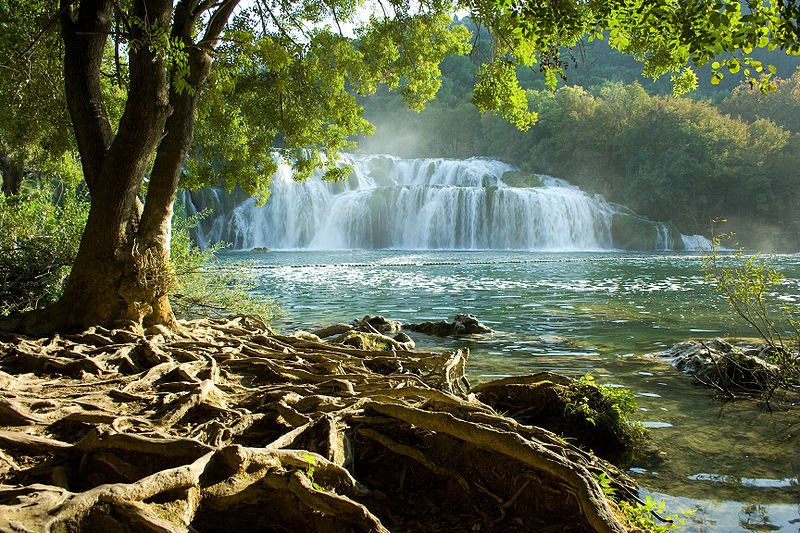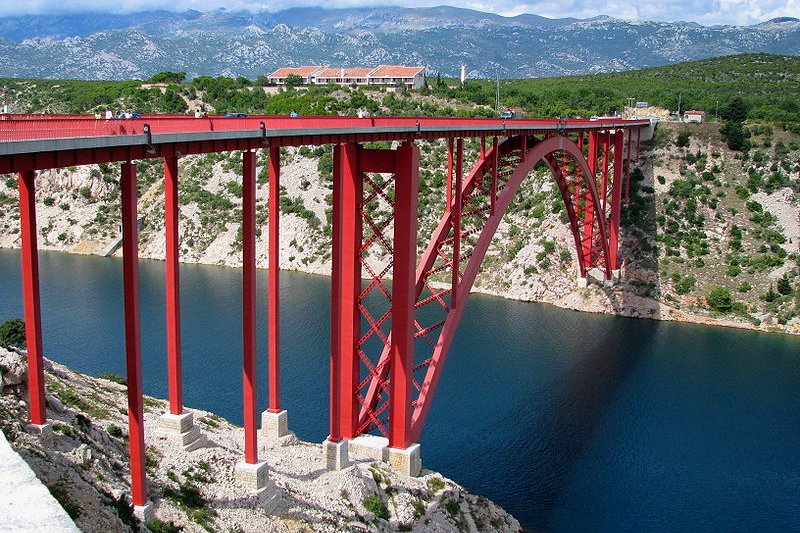 Krka National Park, Croatia
Krka National Park, CroatiaSource: https://commons.wikimedia.org/wiki/File:Nacionalni_park_Krka.jpg
Author: Ytrugg

Croatia is a small country in southern Europe. Shaped like the letter "C", Croatia is bordered by Slovenia to the northwest, Hungary to the northeast, Serbia to the east, Bosnia and Herzegovina to the southeast, and a small section with Montenegro to the extreme southeast. The country has a long coastline facing the Adriatic Sea.
Croatia covers 56,594 sq km (21,851 sq mi) and has a population of 4.5 million (2011 estimate), of which 90% of the population are ethnic Croats and 4.5% Serbs. The capital and largest city is Zagreb. The official language is Croatian. The official currency is the Kuna (HRK). The country is in the Central European Time, which is an hour ahead of Coordinated Universal Time. Traffic is driven on the right here. The phone IDD code is +385. Electricity is 230V/50Hz using European plugs.
 Old Maslenica Bridge, Croatia
Old Maslenica Bridge, CroatiaSource: https://commons.wikimedia.org/wiki/File:Old_Maslenica_Bridge_1.JPG
Author: Ex13

In 2010, Croatia had a nominal GDP of $59.9 billion, and a per capita nominal GDP of $13,528. Its per capita GDP at purchasing power parity is $17,609.
The country is a parliamentary republic headed by a president and a prime minister. It was a kingdom since AD 925 till 1102, when it joined a union with Hungary. It became part of the Habsburg Empire on 1 January, 1527, until it declared independence to become part of the State of Slovenes, Croats and Serbs in 1918. Croatia became one of the six socialist republics of Yugoslavia in 1943. In 1991 it declared independence from Yugoslavia, resulting in a full-scale war between the Serbs and Croats. It ended with Croatian victory in the summer of 1995.
 Cape Kamenjak, Croatia
Cape Kamenjak, CroatiaSource: https://commons.wikimedia.org/wiki/File:Rt_Kamenjak,_Croatia8.JPG
Author: Croq

Planning your visit to Croatia
Visitors from the EU and Bosnia and Herzegovina can enter Croatia with just a valid identity card. Visitors who do not need a visa to enter Croatia include citizens of Australia, Canada, Malaysia and Singapore.Flying in
Zagreb Airport (ZAG) is the main international airport for Croatia. It is also the base for the Croatian flag carrier Croatia Airlines. The airport receives regular scheduled flights from major cities in Europe.
Planning your travel within Croatia
Check the Croatian Railway website (www.hznet.hr) in English for details of passenger trains to different cities in Croatia.Preparing Money for your trip to Croatia
The currency used in Croatia is the Croatian Kuna (HRK).Recommended Travel Guidebook
My favorite travel guidebook for further reading in preparation of your trip is the Croatia Eyewitness Guide, because it follows a format that I find useful to users, not to mention I have also contributed to some of the titles in the Eyewitness series of guidebooks.Major Cities in Croatia
World Heritage Sites in Croatia
Croatia ratified the World Heritage Convention on 6 July, 1992. It has seven sites inscribed on the World Heritage List and a further 16 sites on the World Heritage Tentative List.-
Cultural
- Historical Complex of Split with the Palace of Diocletian (1979)
- Old City of Dubrovnik (1979)
- Episcopal Complex of the Euphrasian Basilica in the Historic Centre of Porec (1997)
- Historic City of Trogir (1997)
- The Cathedral of St James in Šibenik (2000)
- Stari Grad Plain (2008)
Natural
- Plitvice Lakes National Park (1979)
- Zadar - Episcopal complex (2005)
- Historical-town planning ensemble of Ston with Mali Ston, connecting walls, the Mali Ston Bay nature reserve, Stonsko Polje and the salt pans (2005)
- Historical-Town Planning Ensemble Tvrda (Fort) in Osijek (2005)
- Varazdin - Historic Nucleus and Old Town (the Castle) (2005)
- Burg - Castle of Veliki Tabor (2005)
- Lonjsko Polje Nature Park (2005)
- Velebit Mountain (2005)
- Frontiers of the Roman Empire Croatian Limes (2005)
- Diocletian's Palace and the Historical Nucleus of Split (extension) (2005)
- Stari Grad Plain (2005) inscribed in 2008
- Lubenice (2005)
- Primošten Vineyards (2007)
- Hermitage Blaca (2007)
- City of Motovun (2007)
- The historic town of Korčula (2007)
- Kornati National Park and Telašćica Nature Park (2007)
 Latest updates on Penang Travel Tips
Latest updates on Penang Travel Tips

Copyright © 2003-2025 Timothy Tye. All Rights Reserved.

 Go Back
Go Back